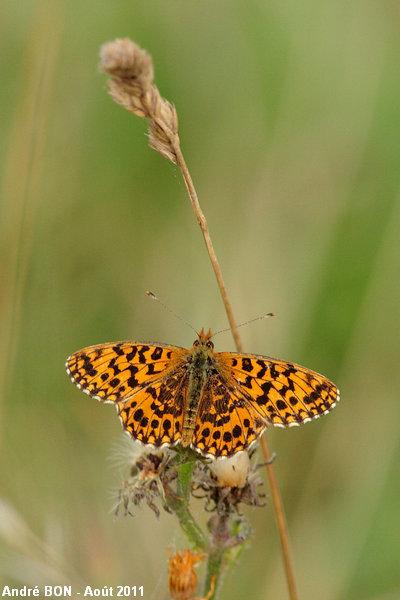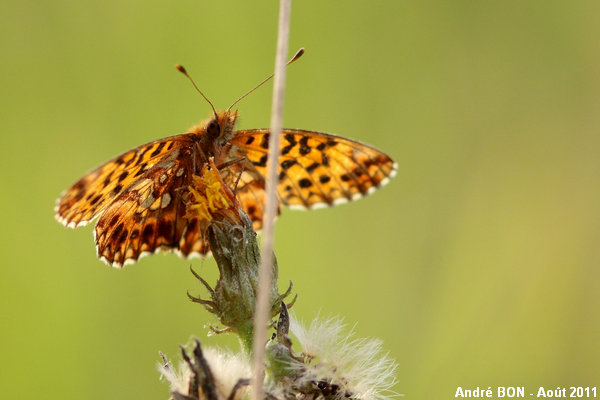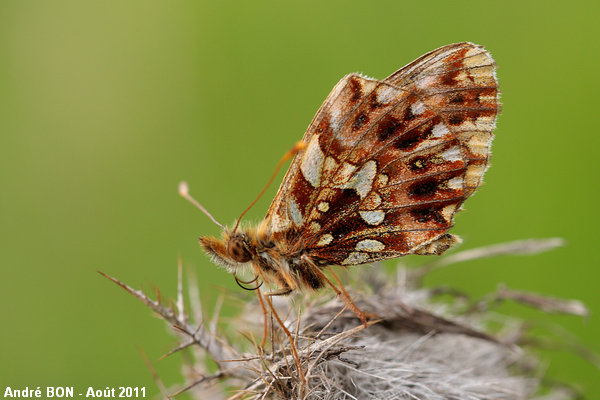



| Weaver's Fritillary (Boloria dia (Linnaeus, 1767)) |




|
|
Scientific name: Boloria dia (Linnaeus, 1767) Common name: Weaver's Fritillary Other names: Violet Fritillary. Other scientific name: Clossiana dia (in fact Clossiana is a subgenus of the Boloria genus, you can also write Boloria (Clossiana) dia). French name: Petite violette Order: Lepidoptera Suborder: Rhopalocera Family: Nymphalidae Subfamily: Heliconiinae Wingspan: 32-36 mm. Biotope: Clearings, woodland edges, waste lands, dry and sunny meadows. Geographic area: Europe from northern Spain to Poland, missing in the British Isles. Asia east to Mongolia. Flight time: April to September. Number of generations : 2 to 3. Caterpillar: Black, marbled with pale grey, with brown and white-tipped spines. Host plant: Violets (Viola sp) and sometimes Brambles (Rubus sp). |
The upper side of the wings is pale orange brown and shows the common pattern of the butterflies of the same genus with one row of triangles and one of dots in the submarginal area. The black marks are broader than on the Small Pearl-bordered Fritillary (Boloria selene), the Pearl-bordered Fritillary (Boloria euphrosyne) and the Cranberry Fritillary (Boloria aquilonaris). The hind wing shows an angulous apex. It is more rounded on the Small Pearl-bordered Fritillary and on the Pearl-bordered Fritillary. Like for all fritillaries, telling species apart is much more easier with a view of the under side of the hind wings. They show small silvery marks on the margin, one row of dark purple spots in the marginal area and rather large silvery discal patches. The central patch is rather elongated, clearly much longer than wide. The underside of the hind wings of the Cranberry Fritillary (Boloria aquilonaris) is very similar, however the central silvery patch is not elongated. This last one also shows one uniform reddish patch near the base of the hind wing. The Weaver's Fritillary does not show this patch. The Weaver's Fritillary over winters as a half-grown caterpillar. |
| [To know more about the Weaver's Fritillary] [Next picture] [Top] |

|
I have only told the Weaver's Fritillary apart after having observed the underside of the hind wings (see the following pictures). This view of the upper side confirms the species identification. This is a small size butterfly with the typical pattern common on butterflies of the Boloria genus but with rather broad black marks. The Weaver's Fritillary is listed in the protected species of the French region Ile de France. |
| [To know more about the Weaver's Fritillary] [Next picture] [Previous picture] [Top] |

|
This Weaver's Fritillary has been very kind to let me turn around and shoot a picture of the underside of the wings. There are sometimes grass stems we would like to cut!! |
| [To know more about the Weaver's Fritillary] [Next picture] [Previous picture] [Top] |

|
All the keys on the underside of wings allowing to tell the Weaver's Fritillary apart are visible on this picture. The Weaver's Fritillaries were used to showing wide open wings during the hot hours of the day. I came back in the evening to see them with folded wings. The numerous blue butterflies observed at the same place show an opposite behaviour, folded wings during the hot hours of the day and wings wide open in the morning or in the evening. |
| [To know more about the Weaver's Fritillary] [Previous picture] [Top] |

|
Another view of the under side of the wings. |